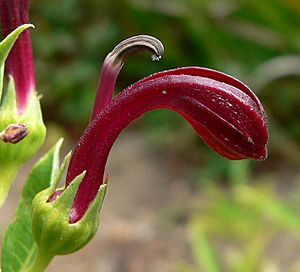Lobelia polyphylla facts for kids
Quick facts for kids Lobelia polyphylla |
|
|---|---|
 |
|
| Close-up of flower | |
 |
|
| At the San Francisco Botanical Garden | |
| Scientific classification | |
| Genus: |
Lobelia
|
| Species: |
polyphylla
|
| Synonyms | |
|
List
|
|
Lobelia polyphylla, also known as tabaco del Diablo (which means "Devil's tobacco"), is a type of flowering plant. It belongs to the Campanulaceae family, which includes many beautiful bell-shaped flowers. This plant grows naturally in the northern and central parts of Chile, a country in South America. It was first described in 1830.
Contents
What is Lobelia polyphylla?
Lobelia polyphylla is a unique plant that stands out in its native Chilean landscapes. It's known for its striking appearance and its interesting common name. The plant can grow quite tall, often reaching heights that make it noticeable in its environment.
Where Does This Plant Grow?
This plant is endemic to Chile. This means it is found only in Chile and nowhere else in the world. It thrives in the dry, sunny conditions of northern and central Chile. You can often spot it growing on hillsides or in rocky areas.
What Does It Look Like?
Lobelia polyphylla has long, slender stems and narrow leaves. Its most eye-catching feature is its flowers. These flowers are usually bright red or orange, growing in clusters along the stem. They have a unique shape that attracts hummingbirds, which help to pollinate the plant. The plant's vibrant colors make it a beautiful sight in its natural habitat.
Why Is It Called "Devil's Tobacco"?
The common name, tabaco del Diablo, is quite intriguing. While it contains the word "tobacco," this plant is not used for smoking like regular tobacco. The name might come from its strong appearance or perhaps from traditional beliefs about its properties. It's important to remember that this plant is not for human consumption.
Life Cycle and Reproduction
Like many flowering plants, Lobelia polyphylla goes through a life cycle that involves flowering, producing seeds, and then growing new plants.
How Does It Reproduce?
The bright flowers of Lobelia polyphylla are designed to attract pollinators. Hummingbirds are especially drawn to its tubular flowers. As hummingbirds feed on the nectar, they help carry pollen from one flower to another. This process, called pollination, allows the plant to produce seeds. These seeds then fall to the ground and can grow into new plants, continuing the species.
Conservation and Importance
Understanding plants like Lobelia polyphylla helps us appreciate the diversity of life on Earth. Protecting its natural habitat in Chile is important for its survival.
Why Protect Native Plants?
Native plants play a crucial role in their ecosystems. They provide food and shelter for local wildlife, help prevent soil erosion, and contribute to the overall health of the environment. By learning about and protecting plants like Lobelia polyphylla, we help keep our planet healthy and diverse for future generations.
See also
 In Spanish: Lobelia polyphylla para niños
In Spanish: Lobelia polyphylla para niños

